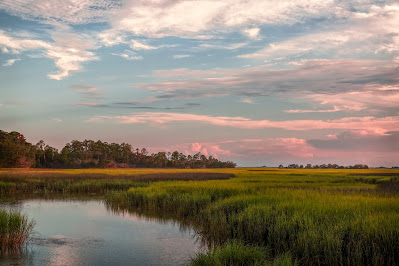 |
| A salt marsh on Sapelo Island, McIntosh County, Georgia. (Adobe Stock photo) |
As the planet warms, flora and fauna are on the move. Sometimes, when animals or plants enter new territory, nothing much changes. Far more often, these moves can cause undesirable consequences. A few movers are shared below, but more can be found here and here.
As temperatures increase along the Gulf Coast, mangroves have spread into the idyllic beauty of Georgia's salt marshes, writes Dan Chapman for the Fish and Wildlife Service. "Mangroves? The tropical plant that shrouds the coastlines of Florida, the Caribbean, and Central America in shadowy, impenetrable greenery? . . . Yup. Mangroves aren't bad. Ironically, one of their major benefits is keeping at bay one of the more insidious effects of a warming world by buffering coasts from ever-rising seas. . . . Mangroves, though, aren't necessarily good either. Georgia's famously beautiful salt marshes. . . could be replaced with mangroves. And the already fragile ecosystem that nourishes migratory birds, fish, crabs, and other animals could be at risk."
Black-legged ticks are moving to climates that have not previously been hospitable to the Lyme-disease-spreading insect. "It's true that the ticks that pass along Lyme disease — which afflicts more than 475,000 Americans each year — are expanding their geographical range, and climate change is one reason why," reports Jeffrey Kluger of Time magazine. Dr. Vishnu Laalitha Surapaneni, an assistant professor of internal medicine at the University of Minnesota Medical School, told him: "We're observing that the tick is moving more into Canada, and higher temperatures do appear to be a key factor. We also see Lyme disease cases in Norway, as well as in the Arctic."
Bumblebees are heading to cooler zones. "There are over 250 species of bumblebees, and they are some of our planet's most important pollinators — without them, we wouldn't have many of our vegetables, fruits, legumes, and other crops," reports the International Fund for Animal Welfare, a global non-profit helping animals and people thrive together. "But due to climate change, rising temperatures are forcing bumblebee populations further north to cooler climates. These temperature changes are also causing spring flowers to bloom earlier than normal, leaving less time for the bees to pollinate them."
No comments:
Post a Comment